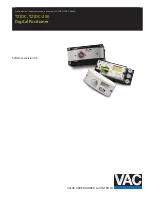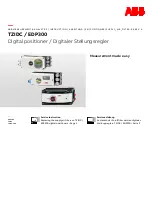
Functions
7100.006434_Bus description_PSD4xx_IO_G_ENG
33
17.08.2020
Tel. +49 7661 39 63-0
info@halstrup-walcher.com
www.halstrup-walcher.com
3) If the direction of rotation (ISDU 115) is changed, the referencing value (ISDU
119), the upper mapping end (ISDU 120) and the upper and lower limit
switches (ISDU 121 and 122) will be reset to the delivery states.
4) If the upper mapping end (ISDU 120) is changed, the upper and lower limit
switches (ISDU 121 and 122) will be reset to the delivery states.
5) If the actual value assessment (numerator; ISDU 116 or denominator; ISDU
117) is changed, the target value, actual value, referencing value, upper
mapping end, upper and lower limit switches, positioning window and loop
length will be recalculated.
6) If the referencing value (ISDU 119) is changed, the target value, actual value,
upper mapping end and the upper and lower limit switches will be recalculated.
7) If the user wants to avoid any automatic adjustment of values when setting the
parameters for the drive, the optimum order for sending the parameters is as
follows:
a) Direction of rotation (ISDU 115),
actual value assessment of numerator (ISDU 116),
actual value assessment of denominator (ISDU 117)
b) Referencing value (ISDU 119)
c) Upper mapping end (ISDU 120)
d) Upper limit switch (ISDU 121),
Lower limit switch (ISDU 122),
Positioning window (ISDU 123),
Loop length (ISDU 124)
8) To save the settings permanently in EEPROM write a 1 in ISDU 194. As soon
as reading ISDU 194 returns a 0, the settings have been saved.
Referencing value (ISDU 119):
With the referencing value (ISDU 119) a shift of the entire value range can be
achieved. The referencing process affects all transferred values, i.e., the target
value, actual value, upper mapping end and upper and lower limit switches.
There are two ways of setting the referencing value:
1) Directly
– by writing the referencing value in ISDU 119.
2) Indirectly
– by writing an actual value to ISDU 68. This makes it possible to
assign any “true” actual value to the current, physical actual value. The
resulting difference is then the referencing value. This value will immediately
be included in calculations for each transferred value and can also be read
under ISDU 119.
If the referencing value is changed, the target value, actual value, upper mapping
end and the upper and lower limit switches will be recalculated.



























